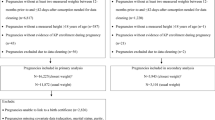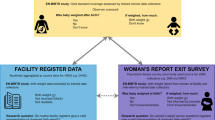Abstract
Low birthweight and preterm birth are associated with adverse health outcomes later in life, but acquisition of accurate birthweight information is not always feasible in large epidemiological studies. We examined the validity of child birthweight and gestational age recall by mothers, and the extent to which recall bias affects associations between birthweight and childhood obesity in children from Bogotá, Colombia. We surveyed mothers of 3,202 schoolchildren aged 5–12 years about child’s weight and gestational age at birth, and sociodemographic characteristics. In a subsample of 279 children, we obtained hospital birth records and extracted birthweight, gestational age, and other perinatal information. Mean birthweight (SD) was 3,106 (739) grams according to maternal recall and 2,977 (462) grams according to hospital records (difference 129 g; 95% CI = 55, 203). Thirty-three percent of mothers recalled their children’s birthweights exactly as they appeared in hospital records. Mother’s age and fewer years of education were each significantly associated with greater birthweight recall bias. Specificity of low birthweight (<2,500 g) and preterm birth (<37 weeks gestation) from maternal recall was 0.95 and 0.86, respectively; however, sensitivity was lower (0.66 and 0.67, respectively). Associations between recalled birthweight and BMI-for-age or overweight during school age were weaker than those with hospital record birthweight. Maternal birthweight recall 5–12 years after birth differs from hospital record birthweight by a clinically meaningful amount. Birthweight recall should be used with caution in epidemiological studies conducted in this and comparable settings. Associations between birthweight and obesity may be stronger than they appear when using recalled birthweight.

Similar content being viewed by others
References
Adegboye, A. R., & Heitmann, B. (2008). Accuracy and correlates of maternal recall of birthweight and gestational age. BJOG: An International Journal of Obstetrics and Gynaecology, 115(7), 886–893.
Sou, S. C., Chen, W. J., Hsieh, W. S., & Jeng, S. F. (2006). Severe obstetric complications and birth characteristics in preterm or term delivery were accurately recalled by mothers. Journal of Clinical Epidemiology, 59(4), 429–435.
Gofin, R., Neumark, Y. D., & Adler, B. (2000). Birthweight recall by mothers of Israeli children. Public Health, 114(3), 161–163.
O’Sullivan, J. J., Pearce, M. S., & Parker, L. (2000). Parental recall of birth weight: how accurate is it? Archives of Disease in Childhood, 82(3), 202–203.
Walton, K. A., Murray, L. J., Gallagher, A. M., Cran, G. W., Savage, M. J., & Boreham, C. (2000). Parental recall of birthweight: A good proxy for recorded birthweight? European Journal of Epidemiology, 16(9), 793–796.
Tomeo, C. A., Rich-Edwards, J. W., Michels, K. B., Berkey, C. S., Hunter, D. J., Frazier, A. L., et al. (1999). Reproducibility and validity of maternal recall of pregnancy-related events. Epidemiology, 10(6), 774–777.
Mbuagbaw, L., & Gofin, R. (2010). Can recall of birth size be used as a measure of birthweight in Cameroon? Paediatric and Perinatal Epidemiology, 24(4), 383–389.
Araújo, C. L., Dutra, C. L., & Hallal, P. C. (2007). Validity of maternal report on birth weight 11 years after delivery: The 1993 Pelotas Birth Cohort Study, Rio Grande do Sul State, Brazil. Cadernos De Saúde Pública, 23(10), 2421–2427.
Hirschler, V., Bugna, J., Roque, M., Gilligan, T., & Gonzalez, C. (2008). Does low birth weight predict obesity/overweight and metabolic syndrome in elementary school children? Archives of Medical Research, 39(8), 796–802.
Sørensen, H. T., Sabroe, S., Rothman, K. J., Gillman, M., Fischer, P., & Sorensen, T. I. (1997). Relation between weight and length at birth and body mass index in young adulthood: Cohort study. British Medical Journal, 315(7116), 1137.
Seidman, D. S., Laor, A., Gale, R., Stevenson, D. K., & Danon, Y. L. (1991). A longitudinal study of birth weight and being overweight in late adolescence. American Journal of Diseases of Children, 145(7), 782–785.
Guerrero-Romero, F., Aradillas-Garcia, C., Simental-Mendia, L. E., Monreal-Escalante, E., de la Cruz Mendoza, E., & Rodriguez-Moran, M. (2010). Birth weight, family history of diabetes, and metabolic syndrome in children and adolescents. The Journal of Pediatrics, 156(5), 719–723.
Tilling, K., Smith, G. D., Chambless, L., Rose, K., Stevens, J., Lawlor, D., et al. (2004). The relation between birth weight and intima-media thickness in middle-aged adults. Epidemiology, 15(5), 557–564.
Arsenault, J. E., Mora-Plazas, M., Forero, Y., Lopez-Arana, S., Marin, C., Baylin, A., et al. (2009). Provision of a school snack is associated with vitamin B-12 status, linear growth, and morbidity in children from Bogota, Colombia. The Journal of Nutrition, 139, 1744–1750.
Lohman, T. G., Roche, A. F., & Martorell, R. (1988). Anthropometric standardization reference manual. Champaign: Human Kinetics.
Hoffman, C. S., Messer, L. C., Mendola, P., Savitz, D. A., Herring, A. H., & Hartmann, K. E. (2008). Comparison of gestational age at birth based on last menstrual period and ultrasound during the first trimester. Paediatric and Perinatal Epidemiology, 22(6), 587–596.
De Onis, M., Onyango, A. W., Borghi, E., Siyam, A., Nishida, C., & Siekmann, J. (2007). Development of a WHO growth reference for school-aged children and adolescents. Bulletin of the World Health Organization, 85, 660–667.
Cole, T. J., Bellizzi, M. C., Flegal, K. M., & Dietz, W. H. (2000). Establishing a standard definition for child overweight and obesity worldwide: International survey. British Medical Journal, 320(7244), 1240–1243.
White, H. (1980). A heteroskedasticity-consistent covariance matrix estimator and a direct test for heteroskedasticity. Econometrica, 48(4), 817–838.
Li, C. Y., Wei, J. N., Lu, T. H., Chuang, L. M., & Sung, F. C. (2006). Mothers tended to overreport categorical infant birth weight of their children. Journal of Clinical Epidemiology, 59(12), 1319–1325.
Gayle, H. D., Yip, R., Frank, M. J., Nieburg, P., & Binkin, N. J. (1988). Validation of maternally reported birth weights among 46, 637 Tennessee WIC program participants. Public Health Reports, 103(2), 143–147.
Buka, S. L., Goldstein, J. M., Spartos, E., & Tsuang, M. T. (2004). The retrospective measurement of prenatal and perinatal events: Accuracy of maternal recall. Schizophrenia Research, 71(2–3), 417–426.
Hakim, R. B., Tielsch, J. M., & See, L. C. (1992). Agreement between maternal interview- and medical record-based gestational age. American Journal of Epidemiology, 136(5), 566–573.
Tehranifar, P., Liao, Y., Flom, J. D., & Terry, M. B. (2009). Validity of self-reported birth weight by adult women: Sociodemographic influences and implications for life-course studies. American Journal of Epidemiology, 170(7), 910–917.
Huxley, R., Neil, A., & Collins, R. (2002). Unravelling the fetal origins hypothesis: Is there really an inverse association between birthweight and subsequent blood pressure? Lancet, 360(9334), 659–665.
Sanderson, M., Williams, M. A., White, E., Daling, J. R., Holt, V. L., Malone, K. E., et al. (1998). Validity and reliability of subject and mother reporting of perinatal factors. American Journal of Epidemiology, 147(2), 136–140.
Rice, F., Lewis, A., Harold, G., van den Bree, M., Boivin, J., Hay, D. F., et al. (2007). Agreement between maternal report and antenatal records for a range of pre and peri-natal factors: The influence of maternal and child characteristics. Early Human Development, 83(8), 497–504.
Lucia, V. C., Luo, Z., Gardiner, J. C., Paneth, N., & Breslau, N. (2006). Reports of birthweight by adolescents and their mothers: Comparing accuracy and identifying correlates. Paediatric and Perinatal Epidemiology, 20(6), 520–527.
Yawn, B. P., Suman, V. J., & Jacobsen, S. J. (1998). Maternal recall of distant pregnancy events. Journal of Clinical Epidemiology, 51(5), 399–405.
Burns, T. L., Moll, P. P., Rost, C. A., & Lauer, R. M. (1987). Mothers remember birthweights of adolescent children: The Muscatine Ponderosity Family Study. International Journal of Epidemiology, 16(4), 550–555.
Acknowledgments
We would like to thank the authorities at the hospitals that provided support for the review of birth charts: Centro Policlínico del Olaya, Clínica Juan N. Corpas, Clínica de Occidente, Clínica Partenón, Hospital Centro Oriente, Hospital la Granja, Hospital Materno Infantil, Hospital Militar Central, Hospital Kennedy, Hospital de San José, Hospital Universitario San Ignacio, Hospital Universitario Clínica San Rafael, and Hospital la Victoria. Funding for this study was provided by the David Rockefeller Center for Latin American Studies at Harvard University.
Author information
Authors and Affiliations
Corresponding author
Rights and permissions
About this article
Cite this article
Boeke, C.E., Marín, C., Oliveros, H. et al. Validity of Maternal Birthweight Recall Among Colombian Children. Matern Child Health J 16, 753–759 (2012). https://doi.org/10.1007/s10995-011-0803-z
Published:
Issue Date:
DOI: https://doi.org/10.1007/s10995-011-0803-z




